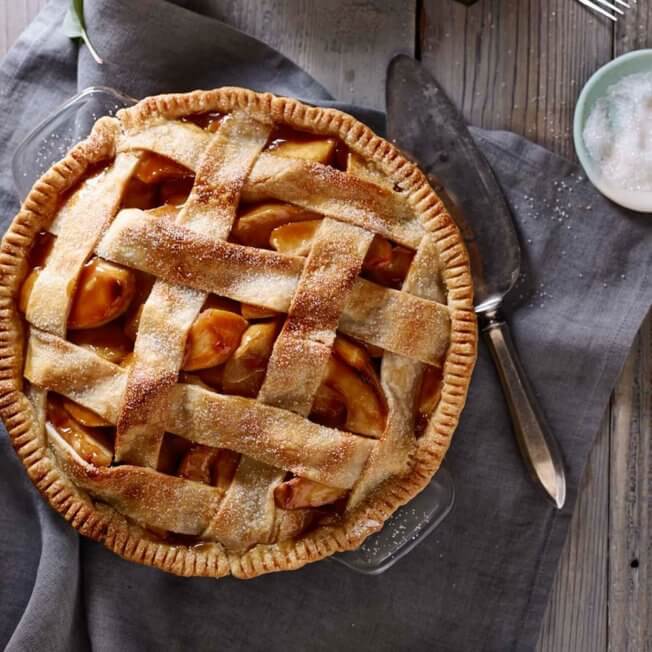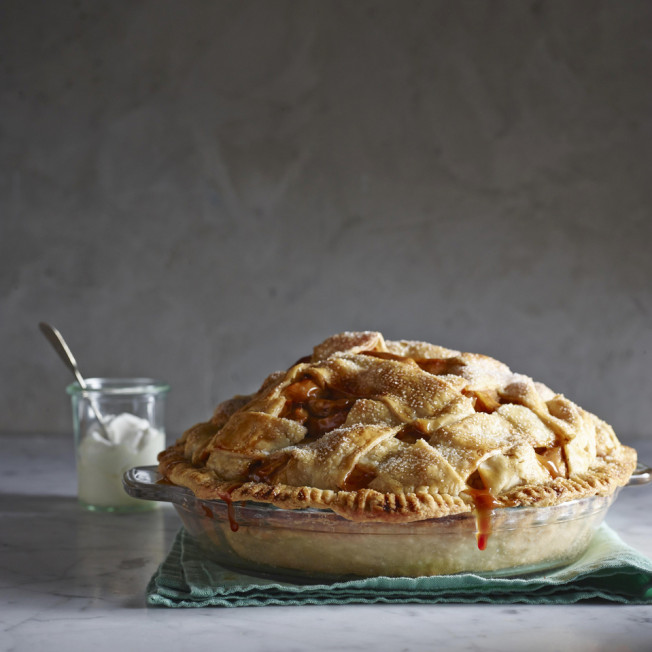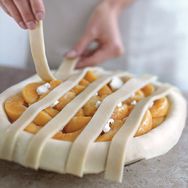In honor of our favorite time to bake, we’ve pulled together everything you need to know about making a classic pie, with foolproof step-by-step tips for every part of the process, from mixing the dough to creating a beautiful lattice top. Read on to master the techniques, then scroll down for some of our favorite recipes for the season.
Technique #1: Making the Dough
Cold butter produces a pie pastry that’s versatile and delicious, creating flaky layers in the crust. To keep it light and crispy, avoid overworking the dough. See the full pie dough recipe here.
 Process the dry ingredients Process the dry ingredientsFit a food processor with the metal blade. Add the flour, sugar and salt to the work bowl. Pulse the machine 2 or 3 times to mix the ingredients evenly. |
 Add the butter Add the butterUsing a sharp knife, cut the butter into 3/4-inch cubes and add them to the work bowl. |
 Pulse to create coarse crumbs Pulse to create coarse crumbsPulse the food processor 8 to 10 times. At this point, some of the butter pieces should be blended into the flour, but bits the size of peas should still be visible. |
 Check the consistency Check the consistencyWhen the dough is done, it should come together in a rough mass in the food processor bowl but not form a ball. Don’t overmix, or the crust will be tough. |
 Shape and chill the dough Shape and chill the doughTransfer the dough to a floured work surface. Shape the dough into a 6-inch disk. Wrap well in plastic wrap and refrigerate for at least 1 hour or up to overnight. |
Technique #2: Working with Pie Dough
Rolling out dough and creating a neat, beautiful edge is simple—just make sure to keep your surface lightly dusted with just enough flour to keep it from sticking.
 Turn and lift the dough Turn and lift the doughUsing a bench scraper or an offset spatula, lift and turn the dough several times as you roll to prevent sticking. Dust the surface and the rolling pin with flour as needed. |
 Brush off the excess flour Brush off the excess flourCarefully roll the dough around the rolling pin, brushing off the excess flour with a pastry brush. Excess flour can make the dough tough. |
 Trim the dough Trim the doughIf making a single-crust pie (shown here), use a small paring knife or a pair of kitchen scissors to trim the dough, leaving a 3/4-inch overhang. |
Technique #3: Blind Baking
“Blind baking” a tart or pie is necessary when the pie filling is uncooked, or when the crust needs to bake longer than the filling. The key is keeping the dough weighted down so it’s easy to fill later on.
 Add weights Add weightsFill the foil-lined crust with pie weights, dried beans or uncooked rice. Make sure the weights cover the entire bottom of the crust. Bake the lined crust until dry, about 15 minutes or according to your recipe. |
 Check the crust Check the crustCheck to see if the crust is ready by pulling up one corner of the foil. If the foil sticks, the crust is not fully dried. Return it to the oven, checking again every 2 minutes. |
 Remove the weights Remove the weightsCarefully remove the weights and foil. Most recipes call for the crust to be baked again until partially baked, about 5 minutes longer, or fully baked, about 10 minutes longer. |
 Let the crust cool Let the crust coolIf filling a fully bake crust with an egg-based filling or for a tart that’s served cold, let the pastry crust cool for at least 30 minutes in the pan on a wire rack. |
Technique #4: Making a Double-Crust Pie
 Fill the pie Fill the pieLine a pie dish or pan with pastry dough, then pour in the filling. Because most fruits shrink as they cook, don’t be surprised if the filling is a few inches above the pie dish rim. |
 Create steam vents Create steam ventsUsing a paring knife, cut 3 or 4 slits in the center of the top crust. This allows the steam to escape while the pie is baking. |
Technique #5: Making a Lattice Top
 Fold back alternating strips Fold back alternating stripsFold back every other dough strip halfway over itself. Place a strip at a sharp angle across the unfolded strips, then return the folded strips to their flat position. |
 Weave the dough Weave the doughFold back the remaining 3 strips, place a dough strip about 1 inch away from the first one and return the folded strips to their flat position. Repeat to complete the lattice. |
Our Favorite Pie Recipes

Now it’s time to make the most of your pie skills with a few of our favorite recipes:
- Salted Caramel Apple Pie with Lattice Crust
- Classic Pumpkin Pie
- Shaker Lemon Pie
- Banana Cream Pie
- Deep-Dish Apple Bourbon Streusel Pie
- Lemon Chiffon Gingersnap Pie
For even more information, including troubleshooting some of the most common pie problems, check out our complete guide to pie.












20 comments
Thanks for sharing this great post. Thanks for talking about this great idea
Really your post inspired me very deeply. I will like your content idea it’s very awesome to read and understand. looking forward to your next post.
This is where the concept memory comes in, because it’s like the foam remembers your bodyshape, allowing you the perfect rest every single period.7 said they want media items (books, CDs, video games) and 35.While they can bend to the shape that you liein it, it’s more ‘general’ rather then the specificsupport that memory foam can do.
Some really marvelous work on behalf of the owner of this website, utterly outstanding subject matter.
I have read so many content concerning the blogger lovers
except this article is genuinely a good post, keep it up.
First off I would like to say terrific blog! I had a quick question which I’d like to ask if you
do not mind. I was curious to find out how you center yourself and clear your head prior
to writing. I’ve had a tough time clearing my mind in getting my thoughts out there.
I do take pleasure in writing but it just seems like the first
10 to 15 minutes tend to be wasted simply just trying to figure out how to begin. Any recommendations or
hints? Appreciate it!
Real instructive and wonderful structure of content
material, now that’s user genial (:.
Fantastic blog you have here but I was wondering if you knew
of any user discussion forums that cover the same topics discussed here?
I’d really like to be a part of community where I can get responses from other knowledgeable people that share the same interest.
If you have any suggestions, please let me know. Bless you!
Thanks for finally talking about >5 Techniques for How to Make Pie | Williams-Sonoma Taste <Loved it!
Good job over again! I am looking forward for your next post;)
I have fun with, lead to I discovered exactly
what I was looking for. You have ended my 4 day lengthy hunt!
God Bless you man. Have a great day. Bye
You are so interesting! I don’t believe I’ve read through
a single thing like that before. So great to find another
person with some unique thoughts on this topic.
Seriously.. thank you for starting this up. This web site is one thing that’s needed on the web, someone with some originality!
Of course, what a great site and educative posts, I definitely will bookmark your website.All the Best!
I’ve recently started a website, the info you offer on this website has helped me tremendously.
Thanks for all of your time & work.
A very helpful guide indeed. Thanks.
You’re welcome! Hope some incredible pie came out of it!
Truly a professional guide! Thanks for sharing it!
You’re so very welcome!
You’re answering spam!
[…] have also been researching how to perfect my lattice crust technique for a possible cherry pie and dreaming up ideas on how to make adorable, miniature cherry pies in […]
[…] Pie Primer (williams-sonoma.com) […]